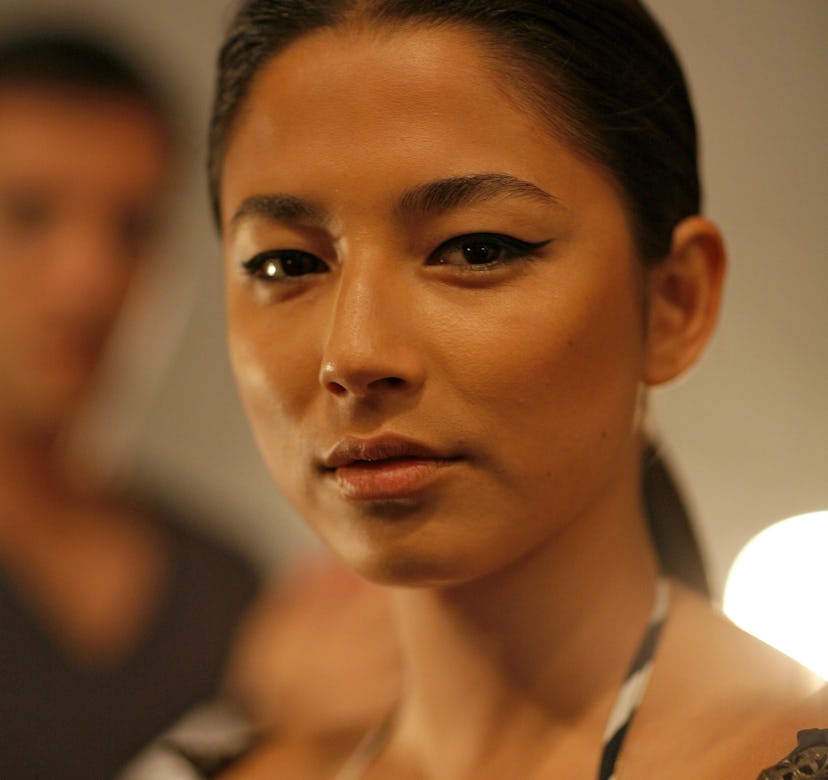(Makeup)
The Major Difference Between Setting & Finishing Powders
Makeup experts weigh in on which formulas may be best for your look.

Ever look in the mirror, full face of makeup, and think, "My makeup looks so oily?" Well, you're not alone, and you could probably avoid moments like that if you simply used the right powder. In case you didn't know, all makeup powders are not created equal, and sometimes, just knowing the difference between setting powder and finishing powder could be the answer to your high-shine woes.
"A setting powder is designed to absorb oil from a complexion product while also locking it in place," says Nick Lujan, Global Director of Artistry & Education at Kevyn Aucoin. "Setting powder is an essential step in the makeup application when transitioning from a cream or liquid to a powder product." Lujan says that a veil of setting powder will create an even set to the creamy or liquid product you've applied, so when applying powder blush, bronze, highlight or contour, the consistencies will blend more seamlessly. "I look at a loose setting powder as almost a primer for powder color products," he says. "It helps facilitate a better blend without skipping." In short, "setting powder sets the makeup you have already applied in areas that call for baking, like under your eyes," Jenna Kristina, celebrity makeup artist and Maybelline New York United States brand ambassador says. By baking, she means leaving on setting powder for extended period of time — think those intense makeup selfies the celebs post.
Finishing powder, on the other hand is more of a "final step" in the makeup application. "It is really geared towards hiding texture, like pores and fine lines," Lujan says. "Some finishing powders contain a little bit of color, which acts as a filter, bringing warmth to the complexion." He notes that a finishing powder doesn’t have setting capabilities, as it doesn’t have the essential ingredients for absorbing oil, most notably, ingredients such as talc. "If you try to set makeup with a finishing powder, you may run into challenges of caking or flaking," he says.
But knowing when to use is key. "Use a setting powder to control shine, lock your foundation and concealer in place, and for touching up 'hot spots'," Lujan says referring to areas of the face that produce more oil and look shiny in photos. He says that one should use a finishing powder as a final step to blur pores or fine lines and, of course, just before you stand in front of the camera lens.
How you apply is also equally as important. For setting makeup, Lujan uses a method he refers to as the press-and-roll. "Load the brush by dipping into the loose setting powder," he says. "Then, hold the brush upright and give it a good tap on the table top. That upright tap forces the powder to drop deep into the bristles. This lends to a cleaner application with little to no fallout (when powder falls out of the brush onto your garment) and a better application without spots of powder that can later show up as dryness." Lujan says once the brush is saturated with product, start by pressing and rolling the brush over areas of concern, the areas with the most texture, or where you produce the most oil. "After you’ve pressed and rolled over the complexion, dust off excess product," he says. But if you don't have a dense brush on hand, there's something else you can try. "Setting powder can be used with a beauty blender," Kristina says.
For finishing powder, however, a smaller and fluffier brush is preferred. "Load the brush in a similar fashion, ensuring the powder is deep in the bristles," he says. "Because it’s a smaller brush, you can be precise with the application to blur pores and fine lines just before it’s photo time."
We only include products that have been independently selected by The Zoe Report's editorial team. However, we may receive a portion of sales if you purchase a product through a link in this article.